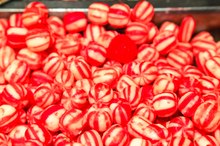What does fact checked mean?
At Healthfully, we strive to deliver objective content that is accurate and up-to-date. Our team periodically reviews articles in order to ensure content quality. The sources cited below consist of evidence from peer-reviewed journals, prominent medical organizations, academic associations, and government data.
- Food and Drug Administration; How Safe are Color Additives?; December 2007
- Food and Drug Administration; Food Ingredients and Colors; November 2004
- Cleveland Clinic: Is it an Allergy or Intolerance?
The information contained on this site is for informational purposes only, and should not be used as a substitute for the advice of a professional health care provider. Please check with the appropriate physician regarding health questions and concerns. Although we strive to deliver accurate and up-to-date information, no guarantee to that effect is made.
Red Food Coloring and Headaches
Seven in every 10 people suffer from a headache at least once a year, and nearly 45 million people in American suffer from chronic headaches, according to a report from the American College of Physicians. While a number of factors play a role in the development of headaches, people often experience headaches because of food intolerances, such as an intolerance to red food coloring.
If you are experiencing serious medical symptoms, seek emergency treatment immediately.
Food Coloring Classifications
The Food and Drug Association classifies all food colorings, including red food coloring, as either exempt from certification or certified. Food coloring made from synthetically produced agents are certified, while those made from natural sources are not. Therefore, red dye number 40 and red dye number 3 -- the only synthetic red food dyes endorsed for use by the FDA -- need certification. However, red dyes made from vegetables, fruits and minerals do not need certification. All food additives -- certified or not -- must meet scrupulous safety standards before gaining approval for use in foods.
- The Food and Drug Association classifies all food colorings, including red food coloring, as either exempt from certification or certified.
Red Food Coloring and Headaches
Allergy to Red Dye in Drinks
Learn More
The consumption of red food coloring causes headaches in some people. These headaches result because of a food intolerance, not a food allergy 2. A food allergy causes an immune response, whereas a food intolerance does not 2. If you have an allergy to a particular food or food additive, you have a reaction regardless of how much you consume. However, if you have a food intolerance, you may be able to eat limited amounts of the food without suffering a reaction. In addition to headaches, other common signs of a food intolerance include:
- nausea
- gas
- abdominal cramping
- bloating
- heartburn
- vomiting
- diarrhea
- irritability
If you experience a headache after consuming a food that you believe contains red food coloring, read the nutrition label to determine what additives it contains and limit your intake of any additive that may create the red color.
- The consumption of red food coloring causes headaches in some people.
- However, if you have a food intolerance, you may be able to eat limited amounts of the food without suffering a reaction.
Foods Containing Red Food Coloring
The foods containing food coloring typically have very low nutritional value, according to the Center for Science in the Public Interest 3. The most commonly used food coloring is Red 40. While some foods still contain Red 3, it was found to produce thyroid tumors in rats and most manufacturers replaced it with Red 40. You may still find Red 3 in a variety of foods, such as fruit roll-ups, chewing gum and cake icing. Read the food label of your food before consuming them to determine if they contain a red food coloring. Common foods containing red food dye include candy, gelatin, cake mixes and soda pop.
- The foods containing food coloring typically have very low nutritional value, according to the Center for Science in the Public Interest 3.
- While some foods still contain Red 3, it was found to produce thyroid tumors in rats and most manufacturers replaced it with Red 40.
Considerations
Does Red Diamond Tea Have Caffeine in It?
Learn More
Repeatedly experiencing a headache after consuming red food coloring may indicate a food intolerance. However, consult your doctor to eliminate the possibility of any other underlying cause. Other common causes of headaches include vision problems, medications, lack of sleep, skipping meals, excessive stress, menstruation, hormone level changes, smoking, loud noises and long car trips.cause:
- Other common causes of headaches include vision problems
- medications
- lack of sleep
- skipping meals
- excessive stress
- menstruation
- hormone level changes
- smoking
- loud noises
- long car trips
Related Articles
References
- Food and Drug Administration; How Safe are Color Additives?; December 2007
- Cleveland Clinic: Is it an Allergy or Intolerance?
- Center for Science in the Public Interest: Chemical Cuisine
- KidsHealth; Headaches; Larissa Hirsch, MD
- AllergyUK. What is Food Intolerance (Non-IgE mediated Food Hypersensitivity)
- Alpay K et al. Diet restriction in migraine, based on IgG against foods: A clinical double-blind, randomized, cross-over trial. Cephalalgia. 2010 Jul; 30(7): 829–837.
- American Academy of Allergy, Asthma and Immunology. Food Intolerance fact sheet.
- Pelsser LM et al. Effects of a restricted elimination diet on the behaviour of children with attention-deficit hyperactivity disorder (INCA study): a randomized controlled trial. The Lancet. 2011 Feb 5;377(9764):494-503.
Writer Bio
Kimberly Wonderly has a Bachelor of Science degree in exercise science and has worked as a personal trainer for six years. Wonderly has also taken many child development classes, while running a daycare out of her home for three years. She wrote for the "Rocket" at Slippery Rock University for two years while attending college.








